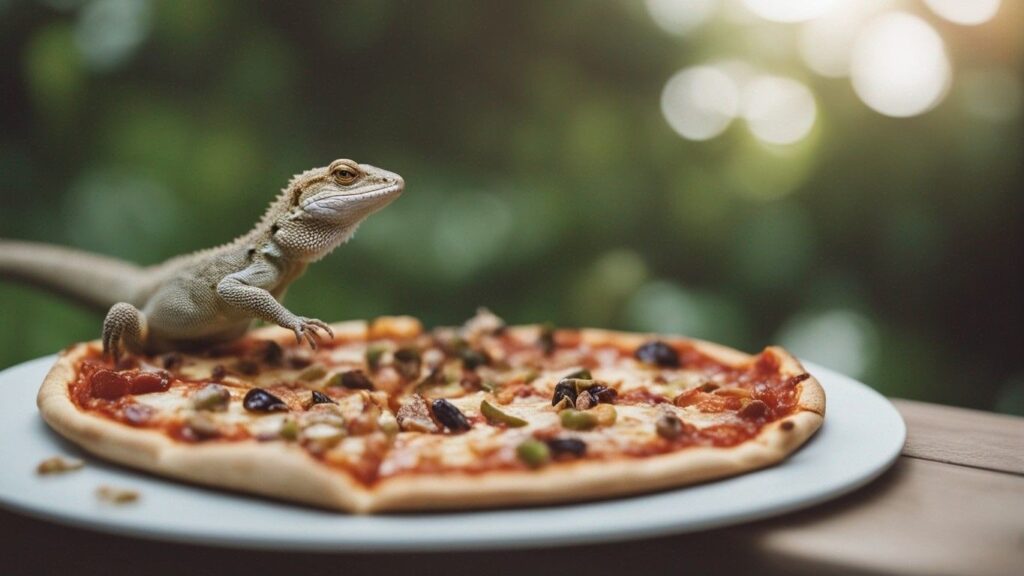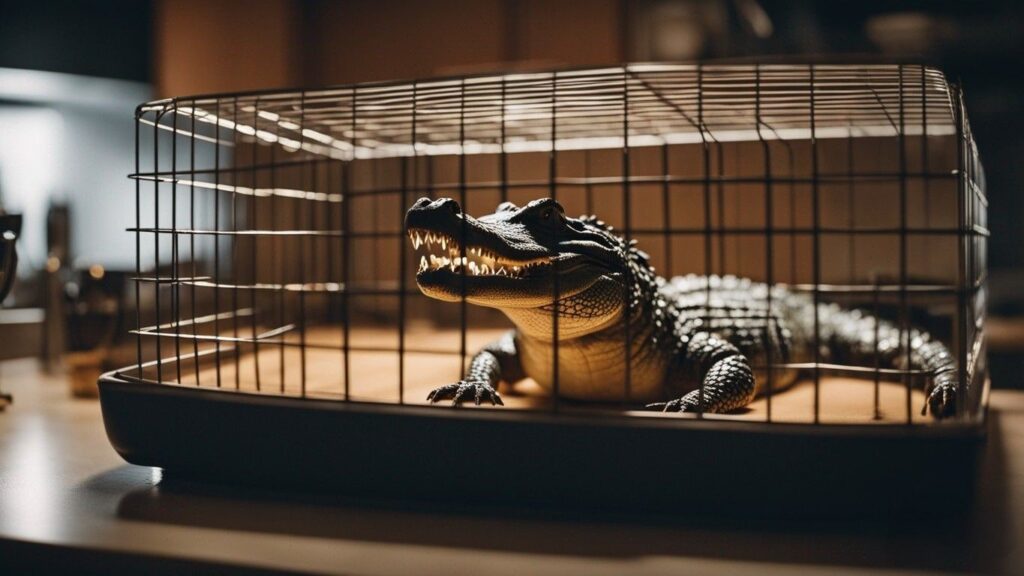
So, you’re on the hunt for a new and unique pet, but you’re not quite ready to commit to a dog or a cat. Well, look no further because we’ve got just the solution for you: pet lizards you can hold.
These scaly companions are not only fascinating to watch, but they’re also perfect for people who prefer a more hands-on approach to pet ownership.
From geckos to anoles, there are plenty of options when it comes to finding a lizard that enjoys being handled.
So, if you’re ready to add a little excitement to your life, keep reading to discover the wonderful world of pet lizards you can hold.
Bearded Dragon
General Information
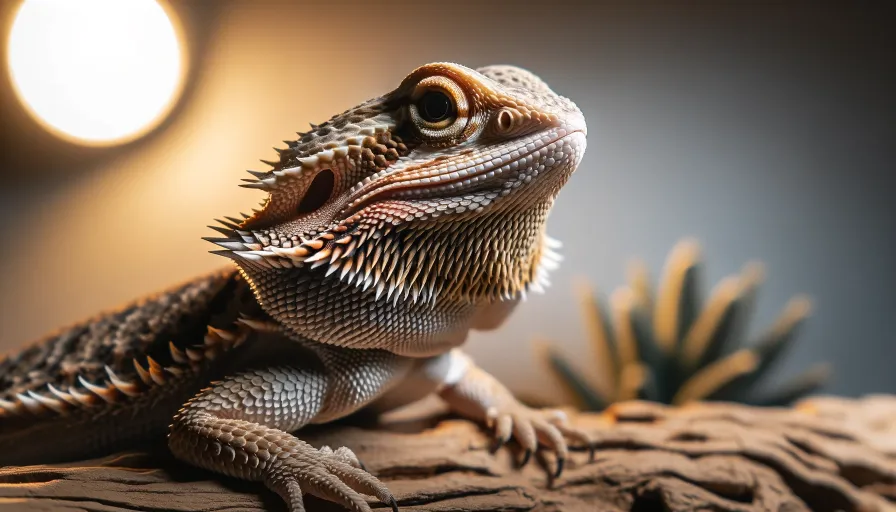
Bearded dragons are popular pet lizards known for their unique appearance and docile nature.
They are native to the arid regions of Australia and are named after their spiky throat pouches, which they can extend to intimidate predators or attract mates.
These reptiles are medium-sized, typically reaching 18-24 inches in length, with a lifespan of around 10-15 years if properly cared for.
Bearded dragons come in various color variations, including shades of orange, yellow, and brown, with patterns that provide camouflage in their natural habitats.
Handling and Interaction
Bearded dragons are generally known for their calm and sociable nature, making them excellent reptile pets for first-time owners.
While they may take a bit of time to get accustomed to handling, with patience and gentle interactions, they can become quite comfortable being held.
Start by allowing your bearded dragon to become familiar with your presence by spending time near their enclosure and offering them treats.
Once they are relaxed and comfortable, gently scoop them up from underneath, supporting their body with your hands.
Always be mindful of their delicate limbs and avoid grasping their tails, as they can become injured or drop their tail as a defense mechanism.
Regular handling is crucial to maintaining a healthy bond with your bearded dragon. Aim for at least 10-15 minutes of interaction per day, gradually increasing the duration as they become more comfortable.
During handling sessions, ensure a secure environment, free from potential hazards or hiding spots where they might escape.
Bearded dragons have a gentle disposition and are known to enjoy perching on their owners’ shoulders or laps while basking in their warmth.
However, always monitor their behavior and never leave them unattended during handling sessions.
Care and Maintenance
Providing a suitable habitat is essential for the well-being of your bearded dragon. Firstly, you will need a spacious enclosure with proper ventilation.
A 40-gallon tank is a minimum requirement for an adult bearded dragon, but larger enclosures are beneficial for their overall comfort.
Inside the tank, create a gradient in temperature by providing a basking spot with a heat lamp, reaching around 95-100°F, and a cooler area around 75-85°F.
It is crucial to maintain proper humidity levels between 30-40%, which can be achieved by misting the enclosure and providing a shallow water dish for drinking and bathing.
Bearded dragons are omnivorous, meaning they require a varied diet consisting of both insects and vegetation.
Their primary diet should consist of appropriately-sized insects, such as crickets, mealworms, or dubia roaches, supplemented with leafy greens, vegetables, and occasional fruits.
Calcium and vitamin supplements should also be provided to ensure proper nutrition.
It is important to establish a feeding schedule that includes both live prey and fresh vegetables, ensuring a balanced diet.
Regular cleaning and maintenance are crucial to keep your bearded dragon’s enclosure hygienic. Remove any feces, uneaten food, or shed skin promptly.
The substrate, the material covering the tank floor, should be easy to clean and replace, such as reptile carpet or paper towels.
Regularly disinfect the entire enclosure and its contents to prevent the growth of harmful bacteria.
Additionally, provide proper UVB lighting to support Vitamin D synthesis, which aids in calcium absorption and overall bone health.
Leopard Gecko
General Information
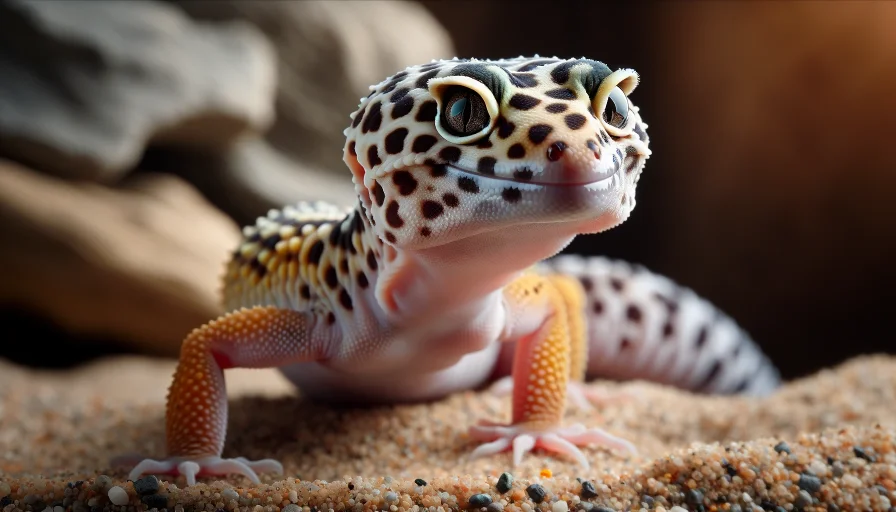
Leopard geckos are small lizards native to the rocky deserts of Afghanistan, Pakistan, and northwestern India.
They are known for their striking patterns and the ability to store fat in their tails, which they use as an energy reserve during periods of scarcity.
Leopard geckos are typically 7-10 inches in length and have a lifespan of around 10-20 years in captivity if cared for properly.
These lizards are highly adaptable and can tolerate a wide range of temperatures, making them popular pets for reptile enthusiasts of all levels.
Handling and Interaction
Leopard geckos are generally docile and easy to handle, making them great companions for those seeking a reptile they can interact with.
However, it’s important to note that leopard geckos are primarily crepuscular, meaning they are most active during dawn and dusk.
Therefore, they may not always be as active or responsive during daytime interactions as some other reptile species.
When handling your leopard gecko, it’s essential to approach them gently and with patience.
Allow them to become accustomed to your presence by reaching into their enclosure and offering them food or allowing them to explore your hand on their own terms.
Slowly and softly scoop them up from underneath, supporting their body with your hands.
Avoid grasping their tail, as it might break off as a defense mechanism. Gradually increase the duration of handling sessions as your leopard gecko becomes more comfortable, but always be mindful of their stress levels and never force interaction.
Care and Maintenance
Creating a suitable habitat is crucial for the health and well-being of your leopard gecko.
A 20-gallon tank is generally sufficient for a single adult leopard gecko, but larger enclosures are recommended to allow for more natural behavior and exploration.
Leopard geckos are terrestrial, meaning they spend most of their time on the ground. Provide a solid substrate, such as reptile carpet or paper towel, to ensure a secure and easy-to-clean flooring.
Leopard geckos require a temperature gradient in their enclosure. A basking spot should be maintained at around 88-92°F, while the cooler areas should range between 75-85°F.
Heating can be achieved through an under-tank heating pad or a heat lamp with a ceramic heating element.
It is important to monitor the temperatures regularly with a digital thermometer. In addition to thermoregulation, leopard geckos also require a hiding spot in both the warm and cool areas of their enclosure to provide a sense of security.
Feeding leopard geckos a balanced and appropriate diet is crucial for their health. These lizards are insectivores, meaning their diet primarily consists of insects.
Suitable options include crickets, mealworms, waxworms, and dubia roaches, depending on the size and age of your leopard gecko.
It is important to provide appropriately sized prey to prevent choking hazards or digestive issues.
Dust the insects with a calcium and vitamin D3 supplement before feeding to ensure proper nutrition.
Maintaining clean and hygienic conditions within the enclosure is essential for a healthy leopard gecko.
Remove any feces, shed skin, or uneaten food promptly. Spot clean the enclosure daily, and conduct a full cleaning at least once a month.
Disinfect the enclosure and its contents with reptile-safe cleaners to prevent the growth of harmful bacteria.
Leopard geckos also require a source of UVB lighting to aid in calcium metabolism and overall wellbeing.
However, some experts argue that leopard geckos can manage without UVB lighting if their diet is appropriately supplemented.
Blue-Tongued Skink
General Information
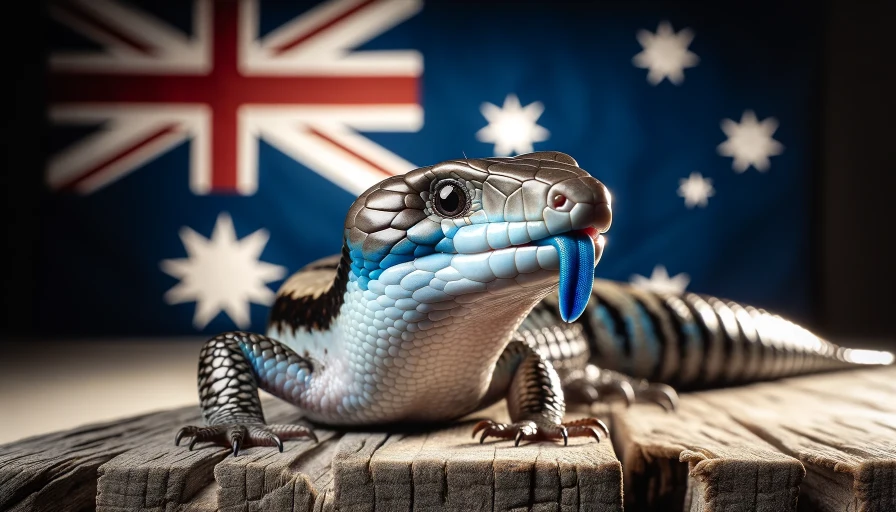
Blue-tongued skinks are fascinating lizards that stand out with their distinctive blue tongues, which they use as a defense mechanism to deter predators.
They are native to Australia and are known for their docile nature and unique appearance. Blue-tongued skinks come in various species, with the most common being the Northern blue-tongued skink (Tiliqua scincoides).
They are medium-sized, reaching lengths of 18-24 inches, and have a lifespan of around 15-20 years in captivity if properly cared for.
Handling and Interaction
Blue-tongued skinks are generally known for being friendly and easy to handle, making them suitable for reptile enthusiasts of all levels of experience.
However, it is important to note that these skinks, like any other reptile, require time to adjust to their new environment before they become comfortable with handling.
Allow them a few weeks to acclimate to their enclosure and establish regular feeding routines before attempting to handle them.
When handling your blue-tongued skink, it’s important to approach them with care and gentleness.
Start by placing your hand near them and allowing them to become familiar with your scent.
Once they are relaxed, gently scoop them up from underneath, supporting their body with your hands.
Avoid grasping their tail, as it can detach as a defense mechanism. It’s important to note that blue-tongued skinks have a slow movement style, so handle them with patience and avoid sudden movements that may startle them.
Regular handling is essential for a healthy bond with your blue-tongued skink. Aim for at least a few minutes of interaction per day, gradually increasing the duration as they become more comfortable.
During handling sessions, it’s important to create a safe and secure environment, free from potential escape routes or hiding spots.
While they may enjoy perching on your shoulder or exploring your hand, always monitor their behavior and never leave them unattended during handling.
Care and Maintenance
Providing a suitable habitat is crucial for the overall well-being of your blue-tongued skink.
A 40-gallon tank is a minimum requirement for an adult, but larger enclosures are recommended for providing more space for exploration and natural behaviors.
Blue-tongued skinks are ground-dwelling lizards, so it’s important to provide a solid substrate, such as reptile carpet, paper towel, or mixed soil, to ensure proper traction and easy cleaning.
Maintaining proper temperature and humidity levels is crucial for the health of your blue-tongued skink.
The temperature gradient should range between 85-95°F on the warm end and 75-85°F on the cool end.
Heating can be achieved through the use of an under-tank heating pad or a heat lamp with a ceramic heating element.
Regular monitoring of temperatures with a digital thermometer is essential. Additionally, provide a shallow water dish for drinking and soaking to maintain proper hydration.
Blue-tongued skinks are omnivorous, meaning they require a varied diet consisting of animal protein and vegetation.
Their diet should primarily consist of a high-quality commercial skink diet or a balanced mix of lean protein sources, such as insects, snails, and ground turkey, combined with leafy greens, vegetables, and fruits.
Calcium and vitamin supplements should be provided regularly to ensure proper nutrition.
Maintaining cleanliness within the enclosure is crucial for the health and well-being of your blue-tongued skink.
Spot clean any feces or uneaten food promptly, and conduct a full cleaning of the enclosure on a regular basis.
Disinfect the enclosure and its contents with reptile-safe cleaners to prevent the growth of harmful bacteria.
Additionally, provide UVB lighting to aid in calcium metabolism and overall wellbeing.
Crested Gecko
General Information
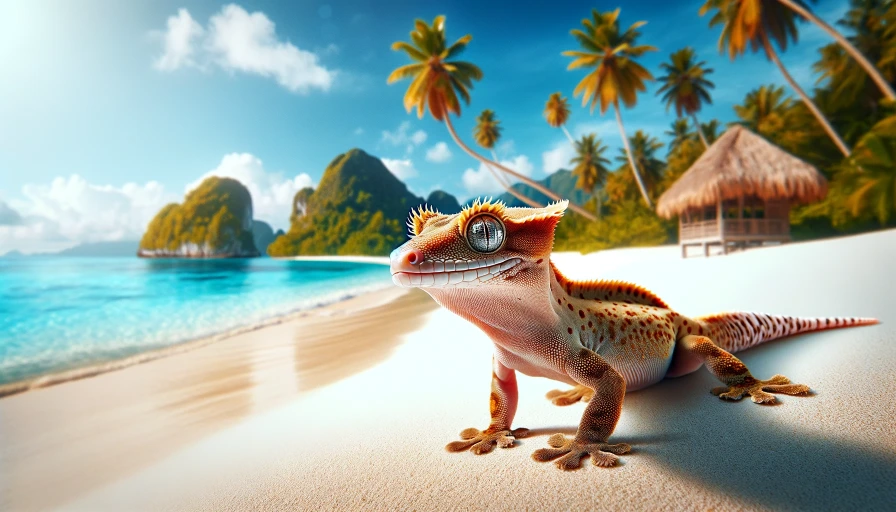
Crested geckos are unique and charming lizards native to New Caledonia, a group of islands in the southwestern Pacific Ocean.
They are known for their striking appearance, especially their fringed crests located above their eyes, running down their head and neck.
Crested geckos are relatively small, typically reaching lengths of 6-8 inches, with a lifespan of around 15-20 years if properly cared for.
These lizards have become increasingly popular as pets due to their ease of care and stunning morph variations.
Handling and Interaction
Crested geckos are generally calm and tolerant of being handled, making them suitable pets for reptile enthusiasts of all ages.
However, it’s important to remember that they are delicate creatures and should be handled with care and gentleness.
Avoid handling young crested geckos until they have reached a minimum weight of 10 grams to minimize stress and potential injuries.
When handling your crested gecko, it’s important to approach them slowly and with patience.
Start by placing your hand near them and allowing them to become familiar with your presence.
Once they are comfortable, gently scoop them up from underneath, supporting their body with your hands.
Avoid grasping their tail, as it can detach as a defense mechanism, but be careful not to drop them.
Remember that crested geckos are arboreal, meaning they are adapted to life in trees, so handle them with care to prevent falls or injuries.
Regular handling is important to maintain a bond with your crested gecko. Aim for short handling sessions a few times a week, gradually increasing the duration as they become more comfortable.
During handling, ensure a safe and secure environment, free from potential escape routes or hiding spots.
Crested geckos are known to be curious and may enjoy crawling on your hand or exploring their surroundings.
While they are generally tolerant of handling, always monitor their behavior and be mindful of their stress levels.
Care and Maintenance
Creating a suitable habitat is crucial for the health and well-being of your crested gecko.
A 20-gallon vertical tank is generally sufficient for a single adult, but larger enclosures are recommended to provide more climbing space and room for natural behaviors.
Crested geckos are arboreal, so it’s important to provide multiple branches, vines, and foliage for them to climb, hide, and jump between.
Live plants, such as pothos or bromeliads, can also be added to create a more naturalistic environment.
Maintaining appropriate temperature and humidity levels is crucial for the health of your crested gecko.
The temperature should range between 72-78°F during the day and can drop to 65-70°F at night.
Heating can be achieved through the use of a low-wattage heat bulb or an under-tank heating pad.
It’s important to monitor temperatures regularly and provide a temperature gradient within the enclosure to allow for thermoregulation.
Crested geckos also require a humidity level of around 70-80%, which can be achieved through regular misting or by using a reptile fogger or humidifier.
Crested geckos are primarily insectivores, meaning their diet primarily consists of insects. However, they also consume fruit and nectar in the wild.
Commercially available crested gecko diets provide a convenient and nutritionally balanced alternative to live insects.
These diets come in powdered form and can be mixed with water to form a paste-like consistency.
Offer the diet in a shallow dish or by smearing it on the sides of the enclosure, allowing the gecko to lick it off.
Additionally, provide occasional live insects, such as small crickets or dubia roaches, to satisfy their natural hunting instincts.
Maintaining proper cleanliness within the enclosure is crucial for the health of your crested gecko. Remove any feces, shed skin, or uneaten food promptly. Spot clean the enclosure daily, and conduct a full cleaning on a regular basis. Disinfect the enclosure and its contents with reptile-safe cleaners to prevent the growth of harmful bacteria. Additionally, provide UVB lighting to aid in calcium metabolism and overall wellbeing. The use of plants within the enclosure can also help maintain humidity levels.
Green Anole
General Information
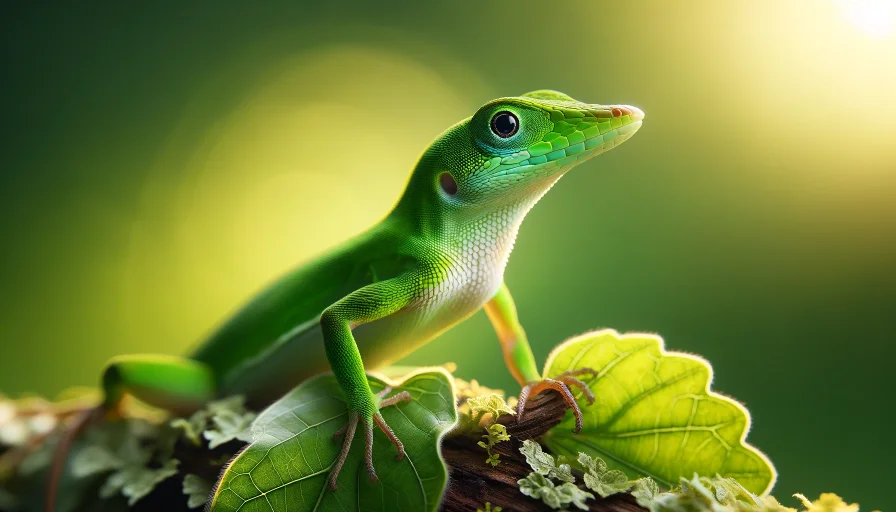
Green anoles, also known as American chameleons, are fascinating lizards native to the southeastern United States.
Despite their nickname, they are not true chameleons. Green anoles are small, slender reptiles, typically reaching lengths of 5-8 inches.
They are named after their ability to change color, displaying shades of green, brown, or gray, depending on their mood, temperature, or stress levels.
Green anoles have a relatively short lifespan of around 2-4 years on average, but with proper care, they can live longer.
Handling and Interaction
Green anoles can be delicate and sensitive, making them less suitable for extensive handling compared to some other lizard species.
While they can become accustomed to their owner’s presence and tolerate brief handling, it’s important to prioritize their well-being and minimize unnecessary stress.
Avoid handling them excessively or for extended periods of time to prevent injuries or anxiety.
When handling your green anole, it’s important to approach them slowly and gently. Use cupped hands to scoop them up from underneath, supporting their body and preventing them from jumping or falling.
Ensure that your hands are clean and free from any chemicals or residue that may harm the lizard.
While they may tolerate brief handling sessions, it’s generally best to observe and appreciate them in their enclosure to minimize stress.
Regular interaction can still be achieved without extensive handling. Spend time near their enclosure, observing their behaviors, and providing a stimulating environment.
Ensure that their habitat contains plenty of hides, climbing branches, and foliage to encourage natural behaviors.
Offering live insects, such as small crickets or fruit flies, in their enclosure can also provide mental stimulation and mimic hunting behaviors.
Care and Maintenance
Creating a suitable habitat is essential for the health and well-being of your green anole. A 10-gallon tank is generally sufficient for a single adult, but larger enclosures or species-specific setups are recommended for multiple individuals.
Green anoles are arboreal and require a vertically oriented habitat to provide ample climbing and perching opportunities.
Provide branches, vines, and foliage throughout the enclosure, mimicking their natural environment.
Maintaining appropriate temperature and humidity levels is crucial for the health of your green anole.
The enclosure should be kept at a temperature ranging from 75-85°F during the day, allowing for a slight drop to 70-75°F at night.
Heating can be achieved through the use of a low-wattage heat bulb, an under-tank heating pad, or a ceramic heat emitter.
Regular monitoring with a digital thermometer is essential. The humidity level should range between 60-70%, which can be achieved through regular misting and by providing a shallow water dish for drinking and soaking.
Green anoles are insectivores, meaning their diet primarily consists of live insects. Appropriate feeder options include small crickets, fruit flies, roaches, and small mealworms.
It’s important to offer a varied diet to ensure proper nutrition. Prior to feeding, dust the insects with a calcium and vitamin supplement to provide essential nutrients.
Avoid using insects caught from the wild to prevent the introduction of parasites or pesticides.
Maintaining cleanliness within the enclosure is crucial for the health and well-being of your green anole. Remove any feces, shed skin, or uneaten food promptly.
Spot clean the enclosure daily by removing any visible debris or waste. Conduct a full cleaning on a regular basis by removing all furnishings, disinfecting the enclosure and its contents, and providing fresh substrate.
Additionally, provide UVB lighting to aid in calcium metabolism and overall wellbeing. Regular observation and interaction with your green anole will help you notice any changes in behavior or health.
Australian Water Dragon
General Information
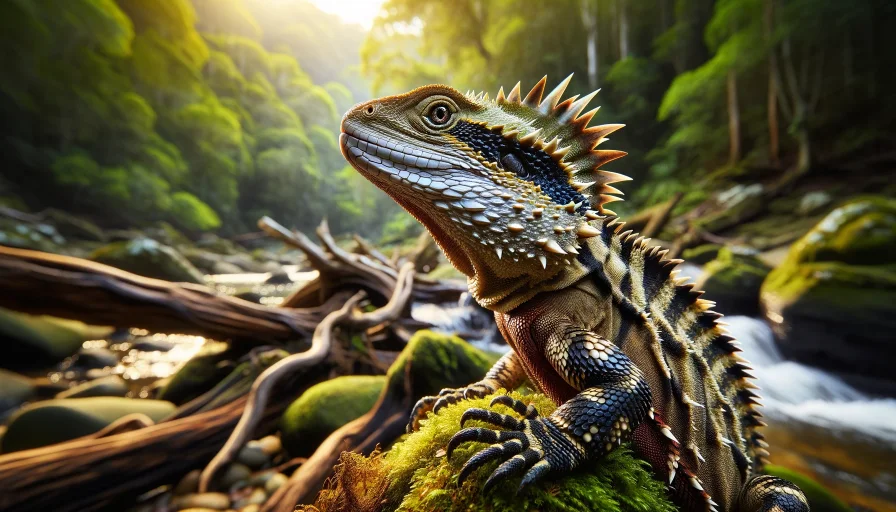
Australian water dragons are fascinating semi-aquatic lizards native to eastern Australia. They are well adapted to life near bodies of water, such as streams, rivers, and dams.
Australian water dragons are medium-sized, typically reaching lengths of 3-4 feet, with males being slightly larger than females.
They have a lifespan of around 15-20 years in captivity if properly cared for. These lizards are known for their stunning colors, elaborate displays, and their ability to swim and dive.
Handling and Interaction
Australian water dragons, while captivating to observe, are generally not suitable for extensive handling.
They are agile and skittish creatures, and their delicate nature requires careful and gentle interaction.
It’s important to prioritize their well-being and minimize unnecessary stress. Avoid handling them unless necessary, such as during health examinations or if they require relocation.
When handling your Australian water dragon, it’s essential to approach them slowly, calmly, and with extreme care.
Use gentle cupped hands to scoop them up from underneath, supporting their body and preventing them from escaping or falling.
It’s important to note that they have sharp claws and powerful tails which they can use as defense mechanisms.
Therefore, it’s crucial to avoid grasping their tail or putting pressure on their limbs. Always keep handling sessions brief and return them to their enclosure as soon as possible.
If you wish to establish a bond with your Australian water dragon, focus on interaction within their enclosure.
Spend time near their habitat, talking softly, and providing visual stimulation. Over time, they may become accustomed to your presence and show signs of recognition and curiosity.
Avoid sudden movements or loud noises that may startle them. It’s important to respect their boundaries and observe them from a distance to allow them to feel secure.
Care and Maintenance
Creating a suitable habitat is crucial for the health and well-being of your Australian water dragon.
A large outdoor enclosure, such as a glass or mesh enclosure, is recommended to provide ample space for them to swim, climb, and bask.
If an outdoor enclosure is not possible, a large indoor enclosure with a secure lid can also suffice.
Ensure that the enclosure has both a land area with branches, rocks, and vegetation, as well as a water area, filled with clean and dechlorinated water.
Maintaining appropriate temperature and humidity levels is crucial for the health of your Australian water dragon.
The enclosure should offer a temperature gradient ranging from 75-85°F on the cool end, up to 90-95°F on the warm end.
Heating can be achieved through the use of basking lamps, ceramic heat emitters, or under-tank heating pads.
Regular monitoring with a digital thermometer is essential. Ensure that the enclosure also maintains a high humidity level, between 60-80%, by misting the enclosure and providing a water source for swimming and soaking.
Australian water dragons are omnivores, with a diet that includes both animal protein and vegetation.
Offer a variety of appropriately sized insects, such as crickets, mealworms, and roaches, as well as small fish and worms.
Additionally, provide a selection of fresh leafy greens, vegetables, and fruits. Proper nutrition is crucial for their overall health, so ensure a balanced diet and offer appropriate calcium and vitamin supplements.
Maintaining cleanliness within the enclosure is crucial for the health and well-being of your Australian water dragon.
Remove any feces, shed skin, or uneaten food promptly. Spot clean the enclosure daily by removing any visible debris or waste.
Conduct a full cleaning on a regular basis by removing all furnishings, disinfecting the enclosure and its contents, and providing fresh substrate.
Additionally, provide UVB lighting to aid in calcium metabolism and overall wellbeing.
Ball Python
General Information

The Ball Python, a fascinating and increasingly popular pet snake, has garnered attention for its unique characteristics and manageable care requirements.
General Information
Background and Species Overview
Ball Pythons, scientifically known as Python regius, originate from sub-Saharan Africa.
They are renowned for their docile nature and striking patterns, making them a favored choice for reptile enthusiasts.
Adult Ball Pythons typically reach lengths of 3 to 5 feet, with females usually being larger than males.
Their lifespan is impressive, often living for 20 to 30 years in captivity with proper care.
Behavior and Temperament
One of the most notable behaviors of the Ball Python is its defensive mechanism. When threatened, they curl into a tight ball, tucking their head inside, hence their name.
Unlike some other snake species, Ball Pythons are generally calm and non-aggressive, making them suitable for beginners.
Handling and Interaction
Tips for Safe and Enjoyable Handling
Handling Ball Pythons is relatively straightforward, thanks to their calm demeanor. However, it’s essential to handle them regularly to maintain their comfort with human interaction.
When picking up a Ball Python, support their entire body and avoid sudden movements.
It’s important to note that handling should be minimized for a few days after feeding to prevent regurgitation.
Understanding Your Python’s Needs
Recognizing stress signals in your Ball Python is crucial. Signs of stress include frequent hiding, hissing, or refusing food.
If these behaviors are noticed, it’s advisable to give your pet some space and reduce handling frequency.
Care and Maintenance
Housing Requirements
A secure and comfortable enclosure is vital for your Ball Python’s well-being. A glass terrarium with a secure lid is a popular choice.
Young pythons can start in a 20-gallon tank, but adults will require a 40-gallon tank. The enclosure should have a temperature gradient, with a basking area around 90°F and a cooler side around 75°F.
Humidity levels should be maintained between 50-60%.
Diet and Feeding
Ball Pythons thrive on a diet of appropriately sized rodents, typically fed once a week.
It’s essential to offer pre-killed prey to prevent injury to the snake. The size of the prey should be roughly the same size as the largest part of the snake’s body.
Health and Veterinary Care
Regular veterinary check-ups are crucial for maintaining your Ball Python’s health. Common health issues include respiratory infections, mites, and digestive problems.
A well-maintained enclosure and proper diet go a long way in preventing these issues.
Chameleon
General Information
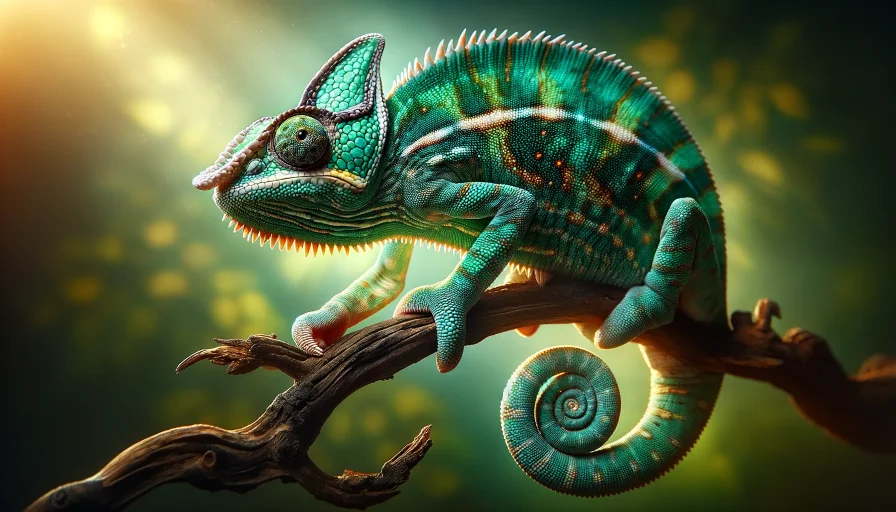
Chameleons are a unique and fascinating group of lizards known for their vibrant colors, distinctive eyes, and their remarkable ability to change their skin color.
Origin and Species Diversity
Chameleons primarily originate from Madagascar and Africa, but some species are also found in parts of southern Europe, Asia, and the Middle East.
There are over 160 species of chameleons, varying greatly in size, color, and lifespan. The most commonly known species include the Veiled Chameleon, Panther Chameleon, and Jackson’s Chameleon.
Unique Features and Behavior
Chameleons are most famous for their ability to change skin color, a feature used for communication, temperature regulation, and camouflage.
They have highly distinctive eyes that can rotate independently, allowing them to have a 360-degree view of their surroundings.
These reptiles are also known for their slow movement and specially adapted tongues, which they use to catch prey.
Handling and Interaction
Guidelines for Safe Handling
Chameleons are generally not fond of being handled and can become stressed if over-handled. When necessary, gentle and calm handling is crucial.
Allow the chameleon to walk onto your hand rather than grabbing it, and avoid sudden movements. It’s important to limit handling to short periods.
Understanding Chameleon Behavior
Recognizing signs of stress in chameleons is essential. Signs include darkening of skin color, hissing, and attempting to bite.
Respecting these signals and minimizing handling can help keep your chameleon relaxed and healthy.
Care and Maintenance
Creating the Right Habitat
Chameleons require a well-ventilated enclosure, such as a mesh terrarium, to thrive. The size of the enclosure should be appropriate for the species, with ample space for climbing and exploring.
The habitat should include a variety of live plants, branches, and vines to mimic their natural environment.
Temperature, Lighting, and Humidity
Maintaining the correct temperature gradient, lighting, and humidity levels is critical for a chameleon’s health.
They need a basking area with temperatures between 75-95°F, depending on the species. UVB lighting is crucial for their wellbeing, as it helps them synthesize vitamin D3. Humidity levels should generally be kept between 50-70%.
Diet and Nutrition
Chameleons are primarily insectivores, feeding on a diet of crickets, roaches, and worms.
It’s important to ‘gut load’ the insects (feeding them nutritious foods before offering them to your chameleon) and to dust them with a calcium supplement.
Some species may also eat plant material or fruits.
Health Considerations
Regular check-ups with a veterinarian experienced in reptile care are essential. Common health issues in chameleons include metabolic bone disease, respiratory infections, and stress-related problems.
A proper diet, adequate UVB lighting, and a stress-free environment are key to preventing these issues.
Red Ackie Monitor
General Information

Red Ackie monitors, also known as spiny-tailed monitors, are impressive reptiles native to Australia.
They are closely related to other monitor lizards, but they are smaller in size, making them more manageable for reptile enthusiasts.
Red Ackie monitors are known for their striking coloration, with vibrant red patterns on their bodies and tails.
They are medium-sized lizards, typically ranging from 24-36 inches in length, with a lifespan of around 10-20 years if properly cared for.
Handling and Interaction
Red Ackie monitors, although visually captivating, are not typically considered “cuddly” lizards.
They are highly active and prefer to spend most of their time exploring their environment and basking in warmth.
While handling should be kept to a minimum, it is important to allow your Red Ackie monitor to become familiar with your presence and associate it with positive experiences, such as feeding.
When handling your Red Ackie monitor, it is essential to approach them slowly and cautiously.
Use cupped hands to gently scoop them up from underneath, supporting their body and minimizing stress.
It’s important to note that Red Ackie monitors can be quick and agile, so always maintain a firm grip and avoid grasping their tail or limbs, as they may try to escape or struggle.
Always be mindful of their stress levels and return them to their enclosure if they appear agitated or uncomfortable.
While direct and extended handling may not be the best option, spending time near their enclosure and providing visual stimulation can still contribute to a healthy and engaging interaction.
Talk softly, offer treats, or simply observe them from a distance. Ackie monitors are known to be inquisitive and may become more tolerant of your presence over time.
Respecting their personal space and providing enrichment in their environment, such as climbing branches or tunnels, can also enhance their overall well-being.
Care and Maintenance
Creating a suitable habitat is crucial for the health and well-being of your Red Ackie monitor.
A large enclosure with a minimum size of 4 feet long, 2 feet wide, and 3 feet tall is recommended for a single adult.
Provide a secure lid or a well-constructed enclosure to prevent escape. As Red Ackie monitors are active climbers, ensure that the enclosure includes multiple branches, rocks, and hides to mimic their natural habitat.
Maintaining appropriate temperature and lighting is crucial for the health of your Red Ackie monitor.
The enclosure should offer a temperature gradient ranging from 120-130°F on the hot end to 85-95°F on the cool end.
Heat can be provided through the use of basking lamps with ceramic heating elements, under-tank heating pads, or radiant heat panels.
Regular monitoring with a digital thermometer and thermostat is essential to prevent overheating or temperature fluctuations.
Additionally, providing a UVB lamp is crucial for their overall health and calcium metabolism.
Red Ackie monitors are primarily insectivorous, with a diet consisting of various insects, such as crickets, mealworms, waxworms, and roaches.
It’s important to offer a variety of appropriately sized prey to ensure proper nutrition. Dust the insects with a calcium and vitamin supplement before feeding to prevent nutritional deficiencies.
Additionally, provide occasional smaller rodents, such as pinky mice or rat pups, as a protein source.
Rotate their diet to provide variety and avoid feeding the same insects exclusively.
Maintaining cleanliness within the enclosure is crucial for the health and well-being of your Red Ackie monitor.
Remove any feces, shed skin, or uneaten food promptly. Spot clean the enclosure daily by removing visible debris or waste.
Conduct a full cleaning on a regular basis, disinfecting the enclosure and its contents. Regular observation and interaction with your Red Ackie monitor will help you notice any changes in behavior or health.
Final Thoughts
Pet lizards can be fascinating companions, bringing a unique and captivating presence to your home.
From the docile nature of Bearded Dragons to the vibrant colors of the Chameleon, there is a diverse range of lizard species that can be enjoyed as pets.
However, it is crucial to understand the specific needs and requirements of each species to ensure their well-being.
Providing a suitable habitat, proper nutrition, and regular interaction are essential for maintaining a strong bond and promoting their overall health.
Whether you choose a Bearded Dragon, Leopard Gecko, Blue-tongued Skink, Crested Gecko, Green Anole, Australian Water Dragon, Ball Python, Chameleon, or Red Ackie monitor, each lizard species offers its own unique beauty and characteristics that make them a captivating addition to any reptile enthusiast’s life.


